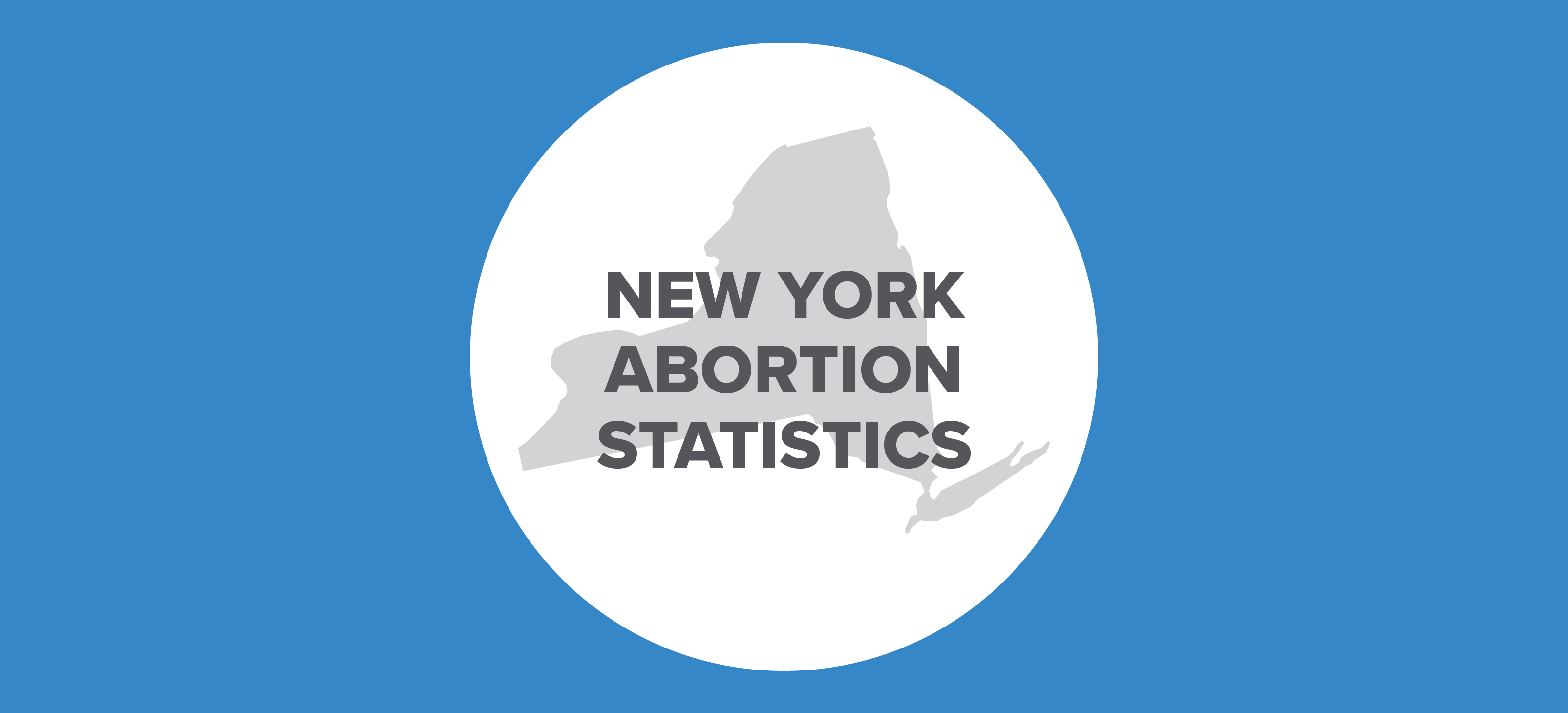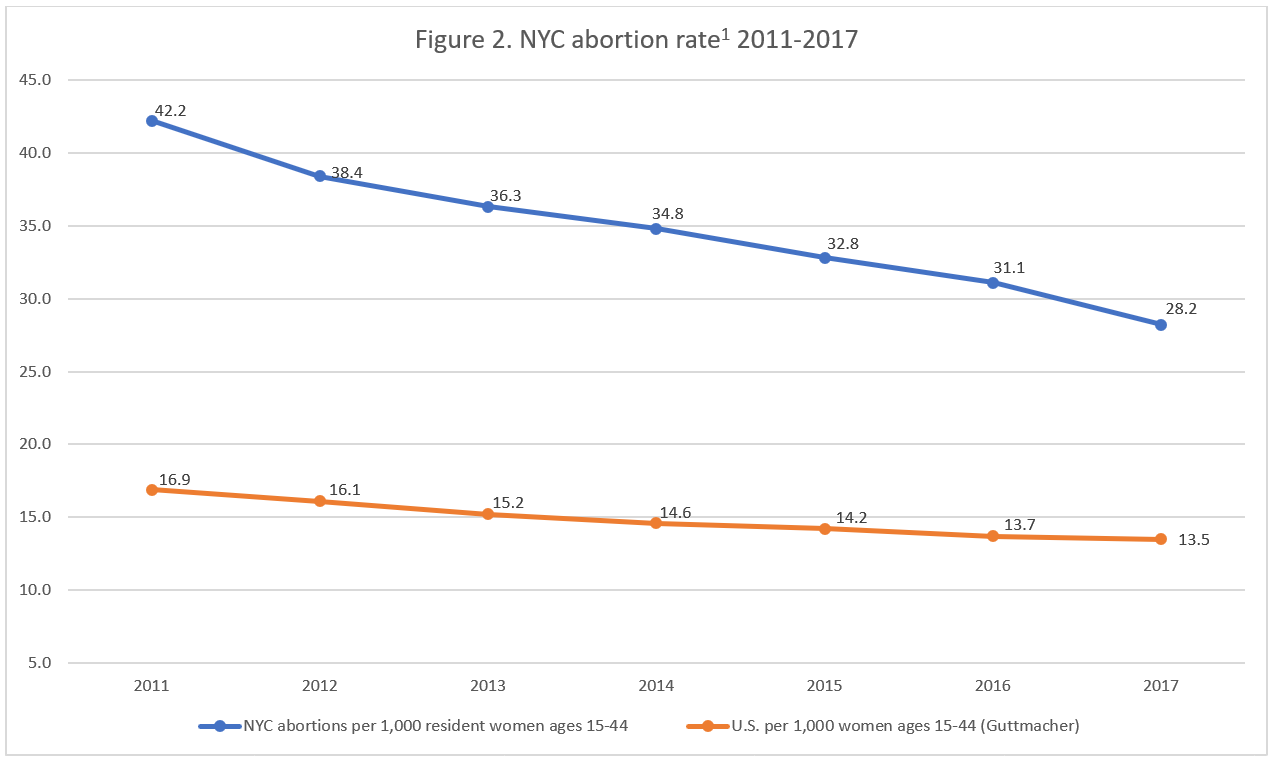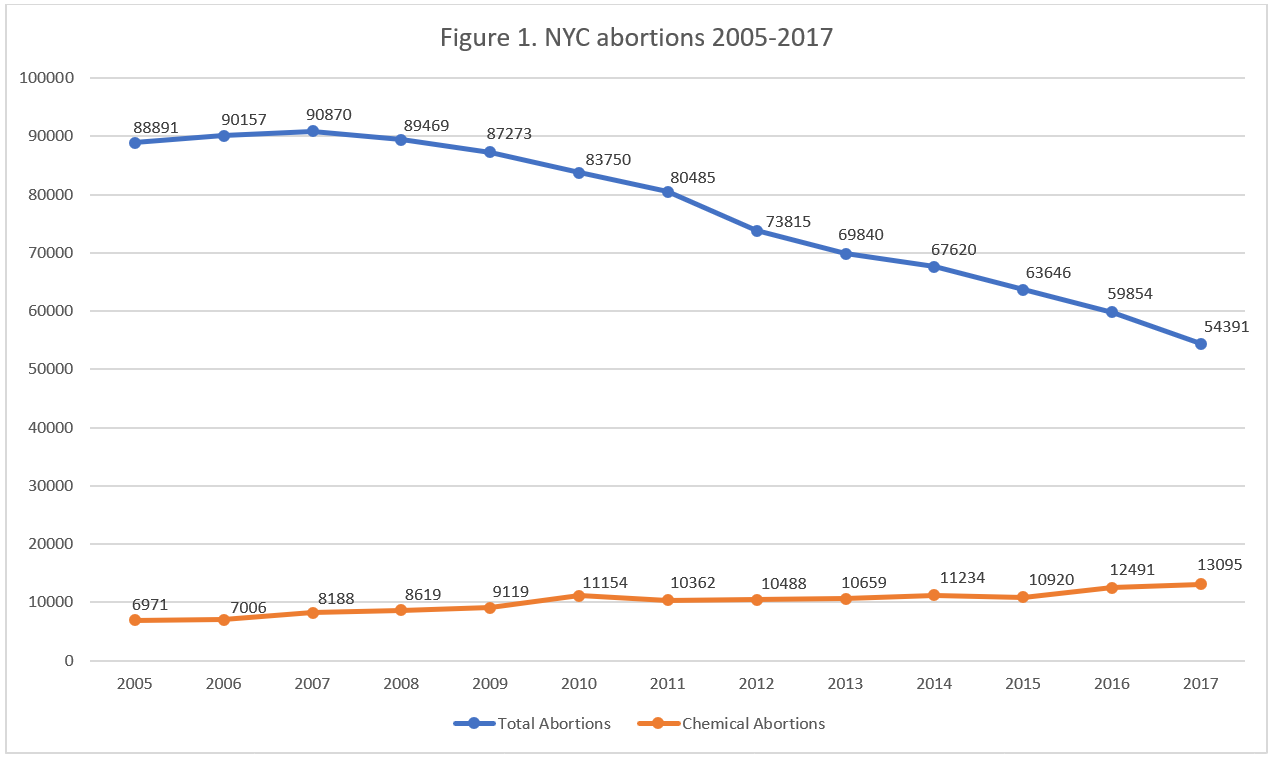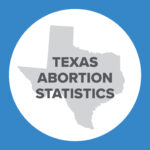Abortion Reporting: New York City (2017)

New York City’s vital statistics report for 2017 was published online by the New York City Department of Health and Mental Hygiene in July 2019. The vital statistics report includes information on abortions performed in the city. New York state also publishes abortion data for the entire state.
Changes in New York City Abortions, 2016-2017

Information on Planned Parenthood’s New York City market share is not publicly available.
Abortion Totals and Trends
There were 54,394 abortions reported in New York City in 2017, a drop of nine percent from the 59,854 reported the previous year. Chemical abortions rose by nearly five percent from 12,491 in 2016 to 13,095, making up 24 percent of the total in 2017 (Fig. 1). Since 2001, chemical abortions in the city have increased by almost 300 percent. New York City reports that its abortion rate in 2017 was 28.2 abortions per 1,000 women of childbearing age, down from 31.1 in 2016, but still one of the highest rates in the nation (Fig. 2).
State Report Summary
Ninety-three percent of the abortions reported in New York City were performed on city residents. Seven percent were performed on nonresidents. Women in their twenties made up more than half (55 percent) of the women who obtained abortions in New York City. Almost a third (32 percent) were in their thirties, and four percent were age 40 or older, while nine percent were under the age of 20. Non-Hispanic black women composed the largest racial group, undergoing 38 percent of the abortions reported in the city. Fourteen percent were non-Hispanic white women, and 27 percent were Hispanic women. Six percent were Asian or Pacific Islander women, and four percent were a different race. Race was not reported for 13 percent of the women. Seventy-three percent of the women were reported to be unmarried, although the true percentage was likely higher because marital status was not reported for 12 percent of the women. Fifteen percent were married.
Nearly two-thirds of the abortions (66 percent) were performed using suction curettage. Twenty-four percent were chemical abortions, and seven percent were dilation and evacuation procedures. Three percent were performed using sharp curettage. There were 52 intrauterine instillation abortions (0.1 percent) and eight hysterectomy/hysterotomy abortions (0.01 percent). Thirty-nine abortions were performed using other, unspecified means.
Forty percent of the abortions reported in New York City occurred at six weeks of gestation or earlier. Another 30 percent were performed between seven and eight weeks, and 13 percent occurred between nine and 10 weeks of gestation. Six percent were performed between 11 and 12 weeks and five percent between 13 and 15 weeks. Four percent were performed between 16 and 20 weeks, and two percent (1,247 abortions) occurred at 21 weeks or later, when unborn babies can feel pain. In 2019, the state of New York passed an extreme abortion law that allows abortion on demand up to 24 weeks of gestation and permits abortions after 24 weeks if the mother’s life or health is at risk or the baby is not viable. The law offers no guidelines on what may be considered a health risk, essentially allowing abortion for any reason throughout all nine months of pregnancy. As CLI’s Dr. James Studnicki points out, the definition of “medical necessity” has become virtually empty in the context of abortion.
Sixty Years of Abortion Reporting
New York City first published abortion data in its 1962 vital statistics report, including abortion statistics for 1958, when 428 abortions were reported in the city. 2017 marks the city’s 60th reporting year and lowest abortion total since the state of New York legalized abortion in 1970. That year, New York City alone reported 44,062 abortions in its vital statistics report, a number which was revised upward to 68,995 in the U.S. Centers for Disease Control (CDC) and Prevention’s 1970 abortion report. New York City abortions skyrocketed in the next two years, jumping to a record high of 203,255 abortions in 1972 – a number which was revised to 223,373 abortions in the CDC report. In comparison, the CDC reports that there were 115,498 live births – almost half the number of abortions – in New York City in 1972.
Before Roe v. Wade legalized abortion throughout the United States in 1973, many women traveled to New York City for abortions. The CDC reports that in 1972, approximately 61 percent of New York City abortions with residence known were performed on out-of-state residents. In 1973, when abortion on demand became legal in all 50 states, New York City abortions dropped to 149,757 and only 40 percent were performed on out-of-state residents. Over the following decades, abortion totals fluctuated but trended downward to a record low in 2017. Despite the tens of thousands of abortions performed in the city in 2017, the report marks thousands of lives saved compared to abortion rates in previous years. At the same time, New York City’s new extreme abortion law could threaten to drive abortion totals up and undo decades of movement in the right direction.
State Ranking
In 2016, the Charlotte Lozier Institute surveyed abortion reporting across the nation. New York City was ranked at 31st best among the 50 states and the District of Columbia. To improve its reporting, New York City could report information that it currently collects on its abortion reporting form, such as the funding source for the abortion and the woman’s level of education, previous pregnancies, and state of residence. The city could also begin collecting data on complications caused by abortion, particularly since abortions performed later in pregnancy have a higher complication rate than earlier abortions do.

- New York City has reported the city’s abortion rate since 2011. The city calculates the rate using the following formula: (total abortions ÷ female population ages 15-44) x 1,000.


























